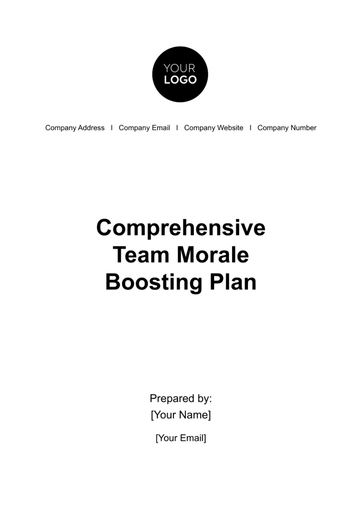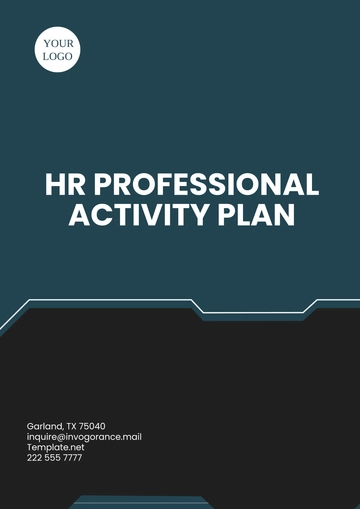Free Professional HR Workforce Contingency Plan

I. Introduction
The Professional HR Workforce Contingency Plan is a thorough approach designed to manage potential workforce disruptions, ensuring uninterrupted business operations during emergencies, crises, or unforeseen events, and offers organized directives for handling the workforce in scenarios like natural disasters, pandemics, economic recessions, or significant employee shortages, while prioritizing operational continuity and employee well-being, aimed at proactive management and swift reaction to minimize disruptions and protect organizational objectives.
Prepared by: Human Resources Department
Date of Creation: January 15, 2060
Next Review Date: January 15, 2065
Version: 1.0
II. Risk Assessment
A thorough risk assessment is critical for identifying potential disruptions that could severely impact the workforce and, consequently, business operations. By understanding the nature, probability, and potential impact of various risks, we can create targeted contingency strategies that address specific needs.
A. Key Risks Identified:
Employee Shortages: This can arise from illness, high turnover, or labor disputes, affecting staffing levels in critical areas.
Natural Disasters: Hurricanes, floods, earthquakes, and wildfires can cause operational disruption, employee safety concerns, and relocation needs.
Pandemics: Health crises, such as global health outbreaks, can result in widespread employee illness, work stoppages, and the need for remote work.
Economic Disruptions: Recessions, market crashes, or financial crises may force significant workforce reductions or restructuring.
Cybersecurity Breaches and Technological Failures: Cyberattacks, system malfunctions, or data breaches can halt operations and compromise sensitive information.
B. Risk Impact Evaluation:
High Probability, High Impact: Pandemics and Economic Disruptions — require immediate and comprehensive responses.
Medium Probability, High Impact: Natural Disasters and Cybersecurity Breaches — can significantly affect operations but are less frequent.
Low Probability, Low to Medium Impact: Employee Shortages — while potentially impactful, can often be managed with temporary staffing solutions or internal reallocations.
III. Workforce Strategy
An effective workforce strategy during a disruption requires a clear framework to adapt to changing circumstances. This section provides action steps for managing employee roles, remote work, and temporary workforce solutions to ensure continuity.
Critical Roles and Key Functions: Identification of essential roles that cannot be easily replaced and whose absence could halt operations.
Example Critical Functions:
Senior Leadership (CEO, Executive Team)
IT Systems & Cybersecurity Teams
Operations and Supply Chain Management
Customer Service, Sales, and Support Teams
Staffing Flexibility and Augmentation:
Remote Work Protocols: Equip employees with the technology and resources to work remotely, ensuring productivity in roles that don’t require a physical presence.
Temporary Staffing: Work with external staffing agencies to hire temporary or contract workers who can step in during high-demand periods or crises.
Cross-Training and Resilience: Invest in cross-training employees to perform multiple roles within the organization, ensuring seamless transitions during staff shortages. Employees will be trained to handle multiple roles across departments (e.g., customer service agents trained for technical support or sales).
Workplace Safety and Employee Wellbeing: Ensure that measures such as PPE, health screenings, sanitization, and social distancing are in place for on-site employees. Remote workers will be supported with mental health resources and ergonomic work setups to mitigate the psychological toll of crises.
IV. Communication Plan
Effective communication is paramount in any contingency plan. Timely, clear, and transparent communication across all organizational levels will ensure that employees are informed, supported, and aligned with the company’s response efforts.
A. Internal Communication:
Real-time Updates: Utilize email, internal portals, and collaboration tools (e.g., Slack, Microsoft Teams) to disseminate critical information quickly.
Crisis Management Dashboard: Create a centralized communication platform where employees can get real-time updates, FAQs, and announcements during a crisis.
Leadership Messaging: Executives will issue regular updates to reassure employees, clarify the organization’s response strategy, and provide motivation.
B. External Communication:
Stakeholder Engagement: Regular updates to external stakeholders (clients, partners, suppliers) will ensure transparency. A dedicated crisis communication liaison will manage these communications to avoid mixed messages.
Public Relations: In the case of a major event, a well-defined public relations strategy will be activated to maintain the company’s reputation and customer trust.
C. Clear Responsibilities:
HR Team: Responsible for disseminating policy changes, updates on remote work arrangements, and employee assistance programs.
C-Suite and Leadership: Oversee communication-related to business strategy and major operational decisions.
Managers and Supervisors: Provide department-specific updates, check on employee well-being, and act as liaisons between staff and leadership.
V. Training and Support
A well-prepared workforce is essential to responding to disruptions effectively. The training programs and support mechanisms in place will ensure that employees are ready to handle unexpected changes in their work environment.
A. Training Initiatives:
Crisis Response Training: All employees, including HR and leadership teams, will undergo regular training on crisis management protocols, emergency response actions, and mental health support.
Remote Work Preparation: Provide comprehensive training on the tools, platforms, and best practices for remote working, ensuring employees remain effective outside the traditional office setting.
Cross-Training Programs: Develop training schedules for employees to learn skills across departments, facilitating a flexible workforce that can easily adapt to new roles during times of crisis.
B. Employee Assistance Programs (EAP):
Mental Health Support: Provide resources such as counseling services, stress management workshops, and 24/7 support hotlines to assist employees in coping with the emotional and psychological impacts of crises.
Work-Life Balance Initiatives: Develop and promote flexible working hours, paid time off, and family care support, especially during extended periods of remote work.
VI. Recovery and Return-to-Work Plan
After a crisis, the recovery phase is essential to restore normal operations. The return-to-work process should be gradual and well-structured to ensure both the health of employees and the efficiency of business operations.
A. Phased Recovery Approach:
Stage 1 (Immediate Response): Critical functions are restored, including customer service and payroll operations, to ensure business continuity. Temporary staff may be employed to assist with urgent tasks.
Stage 2 (Gradual Reintegration): Non-essential staff begin to return, either via remote work or a staggered on-site schedule. Departments focus on stabilizing their operations while continuing with flexible staffing.
Stage 3 (Full Recovery): All departments return to full operational capacity, with processes evaluated for long-term improvements and adjustments based on lessons learned.
B. Post-Crisis Review:
Conduct a thorough review with key stakeholders to evaluate the effectiveness of the contingency plan.
Collect employee feedback and adjust strategies based on employee experiences during the crisis.
VII. Appendix
This section includes additional resources that will support the execution of the contingency plan, ensuring that all information is easily accessible when needed.
Emergency Contact List: A comprehensive directory of emergency contacts, including key personnel in HR, IT, facilities management, and legal teams, as well as external agencies (e.g., staffing agencies, emergency services).
Legal and Compliance Guidelines: Review of labor laws, regulations, and best practices during emergencies, particularly those affecting paid leave, remote work rights, and employee health and safety.
Template Documents: Pre-approved email templates, notification scripts, and checklists to ensure consistency and speed when communicating with employees and external stakeholders during a crisis.
VIII. Conclusion
This Professional HR Workforce Contingency Plan is a dynamic and evolving document that will be reviewed and updated regularly to ensure its continued relevance and effectiveness. By implementing this comprehensive framework, the organization demonstrates its commitment to employee welfare, operational continuity, and resilience during any unexpected challenges. The HR department is responsible for maintaining the accuracy of this plan and ensuring all employees are prepared to act swiftly and efficiently in times of crisis.
- 100% Customizable, free editor
- Access 1 Million+ Templates, photo’s & graphics
- Download or share as a template
- Click and replace photos, graphics, text, backgrounds
- Resize, crop, AI write & more
- Access advanced editor
Keep your HR operations strong during times of crisis with the Professional HR Workforce Contingency Plan Template from Template.net. This editable and customizable template allows HR professionals to plan for workforce disruptions, such as mass absences, resignations, or layoffs. Editable in our Ai Editor Tool, it’s easy to adapt this plan to your company’s structure and needs.
You may also like
- Finance Plan
- Construction Plan
- Sales Plan
- Development Plan
- Career Plan
- Budget Plan
- HR Plan
- Education Plan
- Transition Plan
- Work Plan
- Training Plan
- Communication Plan
- Operation Plan
- Health And Safety Plan
- Strategy Plan
- Professional Development Plan
- Advertising Plan
- Risk Management Plan
- Restaurant Plan
- School Plan
- Nursing Home Patient Care Plan
- Nursing Care Plan
- Plan Event
- Startup Plan
- Social Media Plan
- Staffing Plan
- Annual Plan
- Content Plan
- Payment Plan
- Implementation Plan
- Hotel Plan
- Workout Plan
- Accounting Plan
- Campaign Plan
- Essay Plan
- 30 60 90 Day Plan
- Research Plan
- Recruitment Plan
- 90 Day Plan
- Quarterly Plan
- Emergency Plan
- 5 Year Plan
- Gym Plan
- Personal Plan
- IT and Software Plan
- Treatment Plan
- Real Estate Plan
- Law Firm Plan
- Healthcare Plan
- Improvement Plan
- Media Plan
- 5 Year Business Plan
- Learning Plan
- Marketing Campaign Plan
- Travel Agency Plan
- Cleaning Services Plan
- Interior Design Plan
- Performance Plan
- PR Plan
- Birth Plan
- Life Plan
- SEO Plan
- Disaster Recovery Plan
- Continuity Plan
- Launch Plan
- Legal Plan
- Behavior Plan
- Performance Improvement Plan
- Salon Plan
- Security Plan
- Security Management Plan
- Employee Development Plan
- Quality Plan
- Service Improvement Plan
- Growth Plan
- Incident Response Plan
- Basketball Plan
- Emergency Action Plan
- Product Launch Plan
- Spa Plan
- Employee Training Plan
- Data Analysis Plan
- Employee Action Plan
- Territory Plan
- Audit Plan
- Classroom Plan
- Activity Plan
- Parenting Plan
- Care Plan
- Project Execution Plan
- Exercise Plan
- Internship Plan
- Software Development Plan
- Continuous Improvement Plan
- Leave Plan
- 90 Day Sales Plan
- Advertising Agency Plan
- Employee Transition Plan
- Smart Action Plan
- Workplace Safety Plan
- Behavior Change Plan
- Contingency Plan
- Continuity of Operations Plan
- Health Plan
- Quality Control Plan
- Self Plan
- Sports Development Plan
- Change Management Plan
- Ecommerce Plan
- Personal Financial Plan
- Process Improvement Plan
- 30-60-90 Day Sales Plan
- Crisis Management Plan
- Engagement Plan
- Execution Plan
- Pandemic Plan
- Quality Assurance Plan
- Service Continuity Plan
- Agile Project Plan
- Fundraising Plan
- Job Transition Plan
- Asset Maintenance Plan
- Maintenance Plan
- Software Test Plan
- Staff Training and Development Plan
- 3 Year Plan
- Brand Activation Plan
- Release Plan
- Resource Plan
- Risk Mitigation Plan
- Teacher Plan
- 30 60 90 Day Plan for New Manager
- Food Safety Plan
- Food Truck Plan
- Hiring Plan
- Quality Management Plan
- Wellness Plan
- Behavior Intervention Plan
- Bonus Plan
- Investment Plan
- Maternity Leave Plan
- Pandemic Response Plan
- Succession Planning
- Coaching Plan
- Configuration Management Plan
- Remote Work Plan
- Self Care Plan
- Teaching Plan
- 100-Day Plan
- HACCP Plan
- Student Plan
- Sustainability Plan
- 30 60 90 Day Plan for Interview
- Access Plan
- Site Specific Safety Plan





























